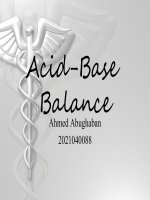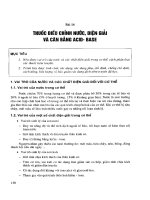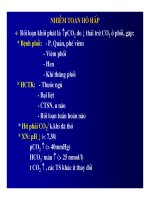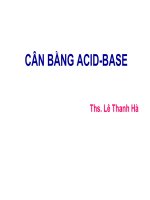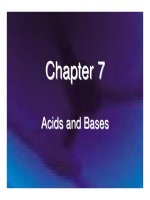Acid base
Bạn đang xem bản rút gọn của tài liệu. Xem và tải ngay bản đầy đủ của tài liệu tại đây (72.35 KB, 2 trang )
- 1 -
Acid-Base
Titrations
1. How many millilitres of 0.100 M HCl are required to neutralize 25.0 mL of 0.100
M Ba(OH)
2
?
2. What is the molarity of a hydrochloric acid solution, 30.0 mL of which is just
neutralized by 48.0 mL of 0.100 M NaOH?
3. Exactly 50.0 mL of HOCl solution of unknown concentration was titrated with
0.100 mol NaOH. An end point was reached when 38.5 mL of the base was added.
Calculate the molar concentration of the HOCl solution.
4. What can make the titrated solution at the equivalence point in an acid-base
titration have a pH not equal to 7.00. How does this possibility affect the choice of
an indicator?
5. What is a good indicator for titrating potassium hydroxide with hydrobromic
acid? Explain.
6. In the titration of an acid with a base, what condition concerning the quantities of
reactants ought to be true at the equivalence point?
7. When 50 mL of 0.10 M formic acid is titrated with 0.10 M sodium hydroxide, what
is the pH at the equivalence point? (Be sure to take into account the change in
volume during the titration.) What is a good indicator for this titration?
8. Calculate the pH of the resulting solution after 20.00 mL of 0.20 M NaOH has been
added to 25.00 mL of 0.20 M HC
2
H
3
O
2
.
9. To obtain the data needed to plot a titration curve for the titration of a strong acid
with a strong base, a chemist used 25.00 mL of 0.1000 M HCl. The molarity of the
base was also 0.1000 M, and this solution was added in small portions to the acid.
Calculate the pH of the resulting solution after each of the following quantities of
base had been added to the original solution (you must take into account the
change in volume). Graph the result.
(a) 0 mL (d) 24.99 mL (g) 25.10 mL
(b) 10.00 mL (e) 25.00 mL (h) 26.00 mL
(c) 24.90 mL (f) 25.01 mL (i) 50.00 mL
10. For each of the following titration, specify the indicator from column II that should
- 2 -
be used. State your reasons, but do not make any quantitative calculations.
Column I Column II
a) NaOH + KHC
8
H
4
O
4
neutral red (6.8-8.0)
b) NaOH + HCl bromocresol green(3.8-5.4)
c) NaHCO
3
+ HCl 0-cresolphthalein(8.2-9.8)
11. ΔH
o
for the reaction H
+
(aq) + OH
−
(aq) Æ H
2
O is - 56.8kJ. Given that the ionic
product of water, K
W
, is 0.61x10
−1
at 291K, calculate K
W
and hence determine neutral
pH at 310K. (Ans: 6.79)
12. Calculate the pH of the following solutions:
(a) 0.05M HCl
(b) 0.1M acetic acid (K
a
= 1.75 x 10
−5
(M))
(c) 0.1M aniline (K
b
= 3.82 x 10
−10
(M))
(d) 0.1M acetic acid plus 0.001 M HCl
(e) 0.16M acetic acid plus 0.044 M sodium acetate
(Ans: 1.3, 2.88, 8.79, 2.27, 4.2)
Polyatomic Acids & Bases
13. Phosphorus acid, H
3
PO
4
, is actually a diprotic acid; K
a1
= 1.0 X 10
-2
and K
a2
= 2.6
X 10
-7
. What are the values of [H
+
], pH and HPO
3
2-
in a 1.0 M solution?
14. Tellurium, in the same family as sulphur, forms an acid analogous to sulphuric
acid and called telluric acid. It exists, however, as H
6
TeO
6
(which looks like
H
2
TeO
4
+ 2 H
2
O). It is a diprotic acid. K
a1
= 2.1 X 10
-8
and K
a2
= 6.5 X 10
-12
.
Calculate [H
+
], pH, and [H
4
TeO
6
2-
] in a 0.25 M solution of H
6
TeO
6
.
15 How many millilitres of 0.05 M phosphoric acid will be required for reaction with
50 mL of 0.50 M KOH to yield
a) KH
2
PO
4
, b) K
2
HPO
4
, c) K
3
PO
4
?
16 Write formulas for the primary, secondary, and tertiary lithium salts of H
3
PO
4
.
Write equations for the equilibria present in an aqueous solution of
a) H
2
SO
4
, b) H
3
PO
4
.

